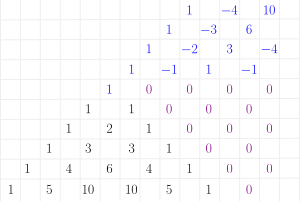Pascal's Triangle: Difference between revisions
| Line 55: | Line 55: | ||
The triangle can be extended to the left also, but it is symmetric to the earlier. | The triangle can be extended to the left also, but it is symmetric to the earlier. | ||
=== Pascal's triangle: half-integers === | |||
Newton: Find the area of the curve <math>y = \sqrt{1-x^2}=(1-x^2)^{1/2}</math>, because it is a quarter of a unit circle <math>A= \frac\pi/4</math>. He couldn't do that, so he took some other powers: | |||
<math> | |||
\begin{equation} | |||
y_0 &= (1-x^2)^{0/2} | |||
= (1-x^2)^0 = 1 | |||
\\ | |||
y_1 &= (1-x^2)^{1/2} | |||
\\ | |||
y_2 &= (1-x^2)^{2/2} | |||
= 1-x^2 | |||
\\ | |||
y_3 &= (1-x^2)^{3/2} | |||
\\ | |||
y_4 &= (1-x^2)^{4/2} | |||
= (1-x^2)^2 = 1 - 2x + x^4 | |||
\\ | |||
y_5 &= (1-x^2)^{5/2} | |||
\\ | |||
\end{equation} | |||
</math> | |||
Revision as of 19:18, 19 October 2022
Introduction
Binomial expansion
Pascal's triangle

The coefficients of binomial expansion can be easily seen from the Pascal triangle. The number is a sum of the two numbers above it.
Pascal's triangle: Negative right
This can be extended to negative numbers easily.

Now, instead of expanding , we will use , where is a negative integer. The exponent of each terms grows when going to left. We get according to the Pascal triangle
And by Taylor series (expansion at Laurent series) we get
- https://www.wolframalpha.com/input?i=series%28+%281%2Bx%29%5E%28-1%29+%29
- https://www.wolframalpha.com/input?i=series%28+%281%2Bx%29%5E%28-2%29+%29
- https://www.wolframalpha.com/input?i=series%28+%281%2Bx%29%5E%28-3%29+%29
Pascal's triangle: Negative left
The triangle can be extended to the left also, but it is symmetric to the earlier.
Pascal's triangle: half-integers
Newton: Find the area of the curve , because it is a quarter of a unit circle . He couldn't do that, so he took some other powers:
Failed to parse (unknown function "\begin{equation}"): {\displaystyle \begin{equation} y_0 &= (1-x^2)^{0/2} = (1-x^2)^0 = 1 \\ y_1 &= (1-x^2)^{1/2} \\ y_2 &= (1-x^2)^{2/2} = 1-x^2 \\ y_3 &= (1-x^2)^{3/2} \\ y_4 &= (1-x^2)^{4/2} = (1-x^2)^2 = 1 - 2x + x^4 \\ y_5 &= (1-x^2)^{5/2} \\ \end{equation} }







